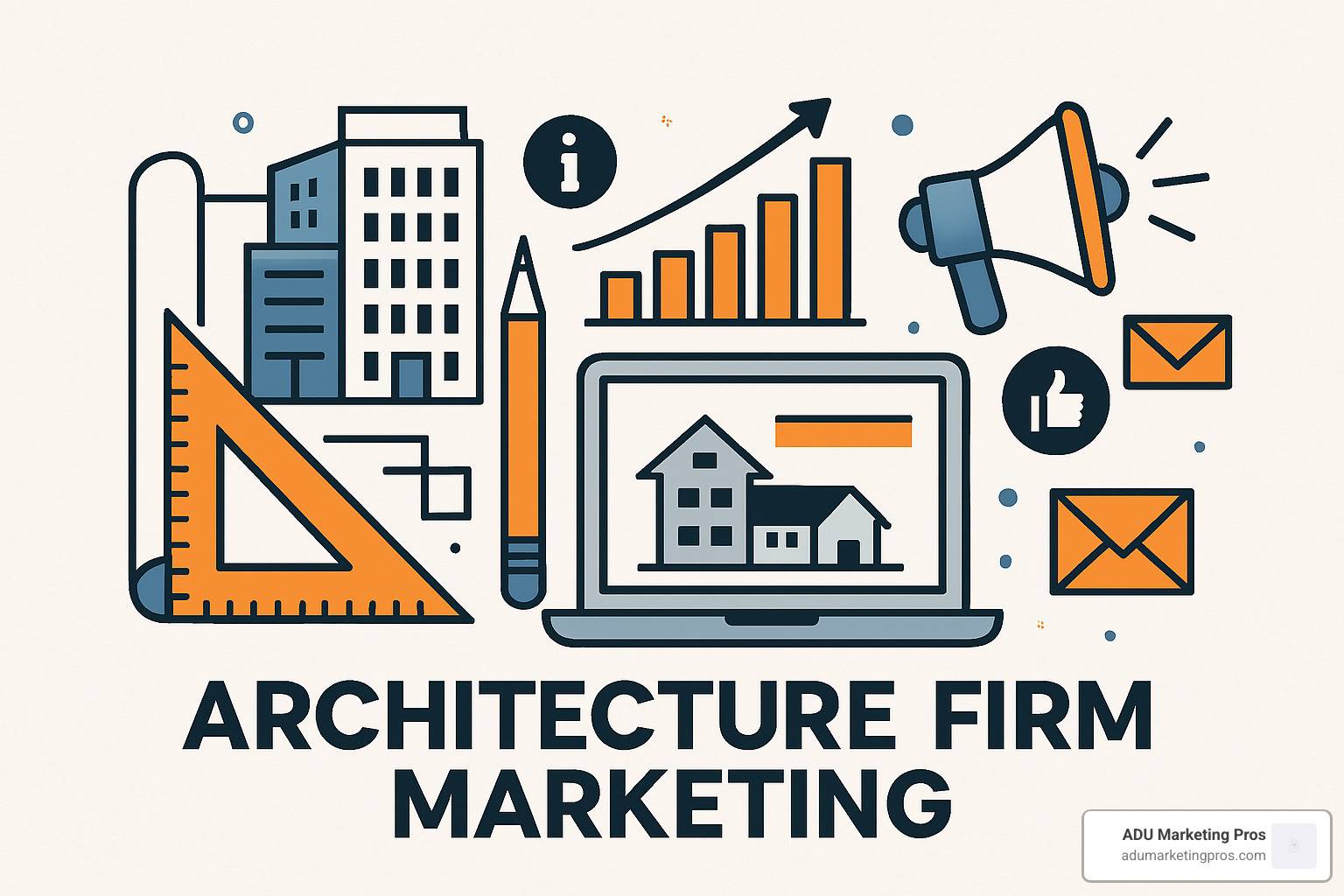Why Architecture Firm Marketing Is Your Ticket Off the Feast-or-Famine Rollercoaster
Architecture firm marketing is the strategic process of attracting, nurturing, and converting potential clients through targeted digital and traditional channels to build a consistent pipeline of quality projects.
Key Architecture Firm Marketing Strategies:
– Content Marketing: Educational guides and project showcases that build trust
– SEO Optimization: Local search visibility for “architect near me” queries
– Social Media: Visual platforms like Instagram to showcase portfolio work
– Email Nurturing: Automated sequences for leads not ready to hire immediately
– Lead Magnets: Free resources like renovation guides to capture contact information
– Referral Systems: Structured approaches beyond hoping for word-of-mouth
If you’ve been in architecture for any amount of time, you know the feast-or-famine cycle. One month you’re drowning in project deadlines, the next you’re staring at empty drafting tables wondering where your next client will come from.
The harsh reality? 91% of potential architecture clients are in the information-gathering stage, not ready to hire immediately. Most firms only target the tiny 3% who are hire-ready right now, missing out on the vast majority of future opportunities.
Traditional referral-only approaches aren’t cutting it anymore. Firms with strategic marketing plans grow 30% faster than those without. Architecture firm marketing isn’t about complicated tactics—it’s about being visible when clients start their research journey, building trust through education, and staying top-of-mind until they’re ready to move forward.

Why Marketing Matters for Architecture Firms Today
Architecture firm marketing has become essential for keeping your firm alive and thriving. Those golden days when stunning work automatically brought in referrals? They’re mostly behind us.
Your potential clients are doing serious homework online before they ever think about picking up the phone. 84% of AEC clients check out a firm’s website before considering a conversation. This means your online presence is often the deciding factor between making their shortlist or being completely invisible.
Digital marketing has exploded into a $460 billion industry and experts predict it’ll hit $786.2 billion by 2026**. Firms with strong digital strategies see 86% better brand awareness and 75% higher credibility and trust** with potential clients.
The High-Stakes Reality of Winning Work
Competition in architecture has gotten fierce. Brand awareness and standing out from the crowd aren’t nice-to-haves anymore—they’re survival skills for attracting quality clients who care about expertise, not just the cheapest bid.
91% of potential clients spend significant time gathering information long before they’re ready to hire anyone. During this crucial window, they’re forming opinions about your firm and deciding whether you understand what they need.
Only about 3% of the market is actually ready to hire an architecture firm right now. Most firms are fighting over this tiny slice, often competing purely on price. Meanwhile, that massive 91% of future clients who are still researching? They’re completely ignored.
Unique Challenges Architects Face
Architecture firm marketing faces unique headaches that other industries don’t deal with. Your sales cycles are marathon-long, often stretching across months or even years from that first “hello” to a signed contract.
Then there’s the spec work trap. Clients expect detailed proposals and preliminary concepts before making any commitments, which means you’re investing serious unpaid time upfront. This makes smart lead qualification absolutely critical.
Regulatory complexity throws another wrench into the works. Most clients don’t understand zoning requirements, permitting processes, or basic design constraints. They often have unrealistic expectations about timelines, budgets, or what’s even possible to build.
Price-shopping has become the default mode for too many clients. Without clear differentiation, firms get stuck in exhausting conversations about who can do it cheapest. This is exactly where strategic marketing becomes your secret weapon for attracting clients who value expertise over bargain hunting.
Architecture Firm Marketing Blueprint: From Awareness to Signed Contract
Architecture firm marketing needs a solid blueprint before you start. Random marketing tactics are like throwing materials at a construction site and hoping they form a house.
Your marketing blueprint starts with understanding exactly what makes your firm different. Maybe you’re the go-to expert for sustainable design, historic renovations, or ADUs. This becomes your Unique Selling Proposition (USP)—the foundation everything else gets built on.
Picture a pyramid. At the very top sits just 3% of potential clients who are ready to hire an architect right now. These folks are getting quotes and making decisions quickly. Most firms spend all their energy here, competing on price.
In the middle—about 6% of the market—are people who know they need professional help but haven’t started serious research yet.
The bottom holds the real treasure: 91% of future clients who are just starting to gather information. They’re asking basic questions like “What does an architect actually do?” Most firms completely ignore this group.
This is where the “Monkey’s Fist” strategy comes in. Sailors used to throw a small weighted knot attached to a rope before hauling over the heavy anchor line. Your marketing works the same way—lead with something small and helpful before asking for the big commitment.
| Marketing Channel | Best For Pyramid Stage | Typical Timeline | Investment Level |
|---|---|---|---|
| Google Ads | Hire-ready (3%) | Immediate | High |
| SEO Content | Information-gathering (91%) | 3-6 months | Medium |
| Social Media | All stages | Ongoing | Low-Medium |
| Email Nurturing | Middle/Bottom (97%) | 6-18 months | Low |
| Networking Events | All stages | Ongoing | Medium |
Stage-by-Stage Architecture Firm Marketing Tactics
Architecture firm marketing gets exciting when you match your tactics to where people are in their journey. For that massive 91% still gathering information, educational content is pure gold.
Lead magnets work beautifully in architecture because people are making such big decisions. A simple guide or checklist provides immediate value while starting the relationship. One architect captured 140 leads in a single weekend at a trade show just by offering a renovation planning booklet.
For prospects who recognize they need help but aren’t ready to hire, case studies become your best friend. Show them how you solved problems similar to theirs. Walk them through your process.
The hire-ready segment needs clear next steps. They’ve done their research and just want to know how to move forward. “Schedule your free consultation” works perfectly here.
Lead Generation for Architects becomes much easier when you understand these different mindsets and craft messages that actually resonate.
Measuring Architecture Firm Marketing ROI
If you’re not measuring your marketing, you’re just throwing money into the wind. The firms that grow consistently are the ones tracking their numbers religiously.
Small businesses typically invest 3-5% of gross revenue in marketing, though firms in growth mode might push that to 7-10% or even 20%. A firm bringing in $1 million annually might allocate $30,000-$50,000 to marketing efforts.
Key metrics include website traffic, lead generation rates, email engagement, social media growth, and new client acquisition costs. You want to know exactly how much it costs to land a new project and which channels deliver the best return.
Dashboard access gives you real-time visibility into what’s working. Google Analytics shows you how people find your website. Email platforms track message engagement. Your CRM system measures how leads move through your sales process.
People who stay organized with their marketing are 674% more likely to succeed. That means documented processes, consistent execution, and regular performance reviews.
Client Demand Pyramid in Action
When you understand the Client Demand Pyramid, it changes everything. Instead of fighting for those few hire-ready prospects, you’re building relationships with the vast majority who will need your services eventually.
That 91% in information-gathering mode aren’t ready for sales pitches—they’ll run if you come on too strong. Your job is to be helpful, not pushy.
Nurturing sequences keep you top-of-mind throughout their extended decision process. You might send helpful emails over several months: “5 Questions to Ask Before Starting Your Project,” followed by “Understanding Design Fees,” and later “How to Prepare for Your First Architect Meeting.”
When prospects finally shift from information-gathering to hire-ready, you’re not a stranger making cold calls. You’re the helpful architect who’s been educating them for months.
Digital Channels That Bring Results
The digital landscape has opened incredible doors for architecture firm marketing, especially when you consider how perfectly your visual work translates online. Your projects are naturally Instagram-ready, your design process tells compelling stories, and your expertise solves real problems people are searching for every day.
Search Engine Optimization (SEO) forms the bedrock of your digital presence. When someone searches “architect near me” or “custom home designer,” your firm needs to show up. Local SEO becomes critical since most architecture work happens within specific geographic boundaries.
Social media gives you powerful ways to showcase finished projects, pull back the curtain on your design process, and establish yourself as the go-to expert. Instagram, LinkedIn, and Facebook work best when you move beyond just showing what you’ve built to explaining why you made specific design decisions.
Email marketing keeps you connected with prospects during those notoriously long architecture sales cycles. Given that most website visitors spend fewer than 15 seconds on your site, email gives you precious opportunities to have deeper conversations.

SEO & Content Engine for Architects
Real SEO for architects means understanding what your potential clients are actually thinking when they search. Someone typing “architect fees” has completely different needs than someone searching “modern house designs.”
The technical stuff matters more than you might think. Site speed, mobile-friendly design, and proper website structure directly impact whether Google shows your site to searchers.
Content marketing through blogging positions your firm as the trusted resource clients turn to for answers. Instead of writing about your latest award, focus on topics like “Navigating Zoning Requirements” or “What to Expect During Permitting.” These articles answer real questions that keep homeowners awake at night.
One architecture firm generated 15,000 website visits from just eight carefully crafted blog posts over a year. Their secret? They stopped writing for other architects and started addressing the specific fears and questions their clients actually had.
Online Marketing for Architects works best when you focus on solving client problems rather than showcasing your design philosophy.
Social Media & Thought Leadership
Social media for architects goes way deeper than posting gorgeous building photos—though please, keep doing that. The real opportunity lies in building genuine relationships, demonstrating your expertise, and staying visible during those months-long decision processes.
Instagram works beautifully for residential architects. Showcase completed projects, share behind-the-scenes moments, and document your design process. LinkedIn tends to serve commercial architects better, offering space for thoughtful industry articles.
Smart hashtag strategies help you reach beyond existing followers. Mix popular general tags like #architecture with specific niche tags like #ADUdesign, then add location-based tags like #SanJosearchitect to capture local searches.
Engagement beats follower count every time. When someone comments on your post, respond thoughtfully. Social media algorithms reward active participation, so being genuinely social actually helps more people see your content.

Email Nurture + Monkey’s Fist Offers
Email marketing delivers one of the highest returns on investment for architecture firms. The secret is providing genuine value instead of constantly asking for the sale.
Segmented email lists let you send targeted messages based on what people actually care about. Someone who downloaded your “ADU Planning Guide” wants different information than someone who requested commercial project details.
The Monkey’s Fist strategy really shines in email marketing. Your initial lead magnet gets prospects into your system, then subsequent emails continue providing value through design tips, project spotlights, and industry insights.
Automated drip sequences handle the nurturing process while you focus on actual design work. A typical sequence might span 6-12 months, offering educational content, relevant case studies, and gentle invitations to take the next step.
Email Marketing for Architects succeeds through this patient, value-first approach rather than aggressive sales tactics.
Budgeting, Execution & Continuous Optimization
Architecture firm marketing doesn’t have to break the bank, but it does need thoughtful planning and consistent execution. The biggest mistake? Throwing money at random tactics without a clear strategy.
Most small businesses invest 3-5% of their gross revenue in marketing. If you’re serious about growth, bump that up to 7-10%. If you’re expanding into new markets, you might need to invest up to 20% temporarily.
Picture this: your firm brings in $500,000 annually. That means setting aside $15,000-$25,000 for marketing. Consider that one good residential project could easily generate $30,000-$50,000 in fees. Your marketing investment starts looking reasonable when you think about it that way.

Smart Budget Allocation & Tools
Spreading your marketing budget too thin kills results. Instead of trying everything at once, focus your dollars where they’ll have the biggest impact.
A solid starting point? Allocate 40% to content marketing and SEO, 25% toward social media and email marketing, 20% for paid advertising, 10% for tools and software, and 5% for networking and events.
You don’t need expensive tools to get started. Asana or ClickUp handle project management. Google Analytics tracks website performance for free. Mailchimp’s free tier covers email marketing for smaller lists.
The magic happens when you connect your marketing activities to actual business results. Track how many people read your blog posts, shared them, and eventually contacted you.
When to Call In Expert Help
Sometimes doing everything in-house just doesn’t make sense anymore. Maybe you’re spending more time wrestling with Google Ads than designing buildings, or your website traffic has plateaued despite your best efforts.
Warning signs include: marketing tasks keep getting pushed aside when project deadlines hit, your website feels stagnant, social media engagement is declining, or you’re not generating enough quality leads.
Professional marketing support can provide specialized knowledge that takes years to develop. Managing effective Google Ads campaigns requires understanding keyword strategies, ad testing, and conversion tracking. SEO involves technical elements that most architects haven’t mastered.
The math is simple: if agency fees are less than the additional revenue from better marketing results, it’s a smart investment. Many firms find that professional support pays for itself through higher quality leads and better conversion rates.
Google Ads for Architects represents exactly this kind of specialized expertise. Rather than spending months learning paid advertising intricacies, you can focus on creating amazing spaces while experts handle the marketing complexities.
Frequently Asked Questions about Architecture Firm Marketing
Why is marketing different for architects?
Architecture firm marketing operates differently than selling shoes or software. The biggest difference? Your sales cycles stretch out like a long construction project—often 6-18 months from first contact to signed contract.
Your clients aren’t buying coffee or even a car. They’re making one of the biggest investments of their lives, trusting you to shape their home or business space. That’s a huge emotional and financial leap that takes time to process.
Most potential clients have no idea what architects actually do. They might think you just draw pretty pictures, not realizing you’re solving complex problems, navigating building codes, and potentially saving them thousands in construction costs. Your marketing has to educate before it can persuade.
Referrals still matter enormously in architecture. But even clients who love your work often struggle to explain why you’re great to their friends. Good marketing gives your happy clients the language to refer you effectively.
How much should we invest annually?
Small firms typically invest 3-5% of gross revenue in marketing, while firms serious about growth often allocate 7-10%. If you’re expanding into new markets, you might temporarily invest up to 20%.
A firm bringing in $1 million annually should budget $30,000-$50,000 for marketing. That covers website optimization, content creation, social media management, email marketing tools, and some paid advertising.
Before you panic, remember this isn’t an expense—it’s an investment. Firms with strategic marketing plans grow 30% faster than those flying by the seat of their pants.
Start small and scale based on what works. It’s better to do three marketing activities really well than to spread yourself thin across ten different tactics.
Which metrics signal success?
Measuring marketing success requires tracking both activities that drive results and actual business outcomes.
Leading indicators show you’re moving in the right direction before revenue hits your bank account. These include website traffic growth, email list expansion, social media engagement, and content consumption rates.
Lagging indicators focus on business impact: qualified leads generated, consultation booking rates, proposal win rates, and client acquisition costs.
Your website analytics reveal visitor behavior patterns. Email marketing success shows up in open rates around 20-25% and click-through rates of 2-5%. For social media, engagement matters way more than follower count.
The ultimate metric? New client acquisition cost. If your marketing generates $100,000 in new project fees while costing $15,000 to execute, that’s a clear win.
Conclusion
Architecture firm marketing doesn’t have to be rocket science. You don’t need a massive budget or a team of marketing experts to get started. What you need is a shift in thinking—from waiting for the phone to ring to actively building relationships with future clients.
91% of your potential clients are out there right now, quietly researching their options. While your competitors fight over the tiny 3% ready to hire today, you have an incredible opportunity to connect with everyone else.
The feast-or-famine rollercoaster doesn’t have to be your normal. Firms with strategic marketing plans grow 30% faster than those winging it, and that growth builds on itself over time.
Start simple. Get your website telling your story clearly. Write helpful blog posts answering common questions. Post consistently on social media—not just pretty pictures, but real insights into your process. Set up a basic email system to stay in touch with people who aren’t ready to hire yet.
Marketing is like good design—it takes time to get right. Be patient with yourself as you learn what resonates with your ideal clients. Treat your marketing efforts with the same professionalism you bring to your design work.
Online Marketing for Architects provides the roadmap, but success comes down to showing up consistently and providing real value to people who need your expertise.
At ADU Marketing Pros, we’ve seen how the right marketing approach transforms architecture firms. We understand the unique challenges you face, especially in California’s competitive ADU market. Our approach helps firms like yours stand out by showcasing expertise rather than competing on price alone.
Those empty drafting tables don’t have to stay empty. Your ideal clients are out there searching for someone exactly like you. The question isn’t whether they need what you offer—it’s whether they’ll find you when they’re ready to move forward.
Your next great project is probably starting as a Google search right now. Make sure you’re there when it happens.




